Continued from page 1.
IMPERIAL DAM LTVA, CALIFORNIA: JAN. 1 -
MARCH 14, 2012
LTVA stands for Long-Term Visitor Area. This is a very cool
boon-docking concept courtesy of our federal government. I'll explain
it briefly here.
There are millions of acres of Bureau of Land Management (BLM)
land in thirteen western states. Quite a bit of it is
desert land in southern CA and AZ.
Campers can park their
RVs on much of this BLM land for free but there is usually a
limit of fourteen days in any one spot. I've already groused
about that during our summer trips to Silverton, CO because we'd
like to stay at the dispersed campground at South Mineral Creek
for more than two weeks. In other places we've visited, two
weeks is enough and we're ready to move on.
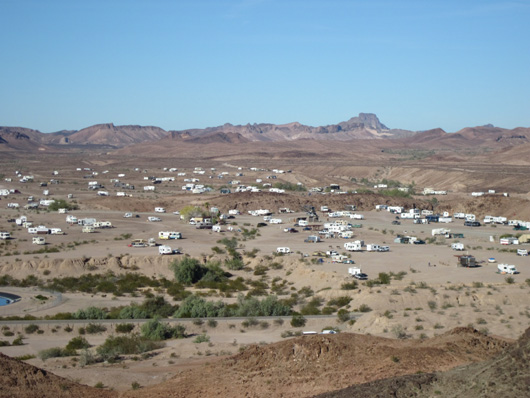
Part of the 3,500-acre Imperial Dam LTVA
where we boon-docked for 10 weeks;
our site was in the far distance. I took
this photo from Hurricane Ridge. (1-4-12)
Thousands of acres of BLM land in southeastern CA and
southwestern AZ is contained in seven LTVAs that allow visitors to
stay at one site -- or move around to any of the other
LTVAs -- for up to seven months between September 15 and
April 15 each year.
That's a clear advantage for snowbirds who spend several months
in the desert because they can stay put in one place if they
want.
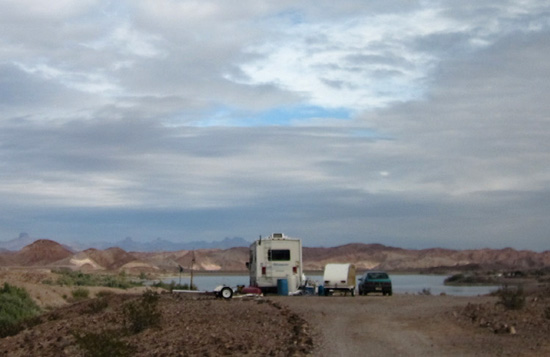
Folks who arrive at Imperial Dam early
enough in the fall can claim a site like this
with a great view of Senator Wash Reservoir
and the Dome Mountains (that's not our RV). 1-15-12
There is a nominal fee ($40 for up to two weeks or $180 for up
to seven months) but each LTVA site offers some amenities to
make desert boon-docking more comfortable -- some more,
some less.
The LTVA we chose at
Senator Wash Reservoir near Imperial Dam provided potable water,
dump stations, bathrooms with showers, trash bins, limited
postal services, and numerous group activities if folks wanted
to participate in them. You're lucky at most free BLM areas to
have a trash bin and pit toilet.
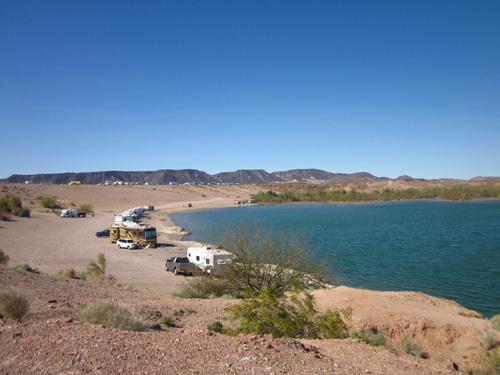
RVs at Senator Wash Reservoir near Imperial
Dam; we were
camped in the LTVA above the lake in
the far distance. (3-4-12)
When we arrived at Imperial Dam the office was closed so we had
a couple days to decide how long we might stay. We were happy
with the site we found and delighted to discover we had
decent TV, phone, and internet (MiFi) reception so far from
civilization.
So we decided to pay the $180 fee and stay a while.
Over ten weeks our average daily camping fee was a mere $2.46.
People who stay longer get by even cheaper than that. We did
have to buy some propane and gasoline but it was still a very
inexpensive way to live for ten weeks.
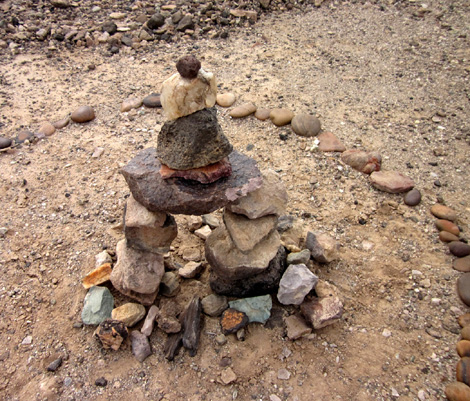
Rock art is popular at Imperial Dam; I
built this figure
with stones found at our campsite and in
the nearby desert. (2-7-12)
We were happy enough with Imperial Dam that we didn't move
around to any of the other six LTVAs. We checked out four of
them on drives in the truck -- the very popular and
usually very crowded Quartzsite, AZ area,
about 80 miles north of us, and three small LTVAs in CA off I-8 west
of Yuma. There are two more off I-10 in CA that we didn't see.
The LTVA at Senator Wash Reservoir is on the California side of
the Colorado River, adjacent to Imperial Dam. It comprises 3,500
acres of desert about 20 miles north of Yuma, AZ. That was where
we shopped.
It was a pleasant drive to Yuma on either side of the river through
verdant farmland where vegetables and citrus fruits were being
harvested all winter:
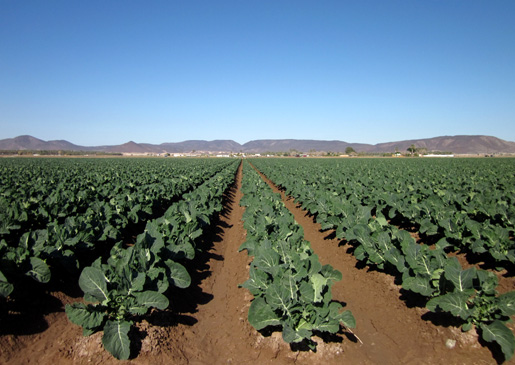
Even though there were probably a couple thousand RVs in our
LTVA at the height of the season in January and February, we
found a great site with at least an acre of land on the
northwest side of the property.
Folks who wanted to be close to
each other could be close; those of us who wanted more space
could easily find it. Our closest neighbors were at least 100
feet away and usually more than that.
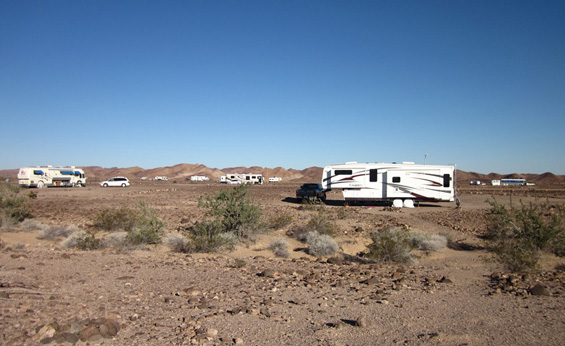
This was our "back yard." Our camper is in
the foreground. The "front yard" is shown below. (1-2-12)
Folks came and went the whole ten weeks we were there. Two of
our neighbors were there longer than us, giving us some
continuity.
We had a long "driveway" back to our large circle defined with
interesting stones left by previous occupants. Some folks have
come here for 20 or 30 winters! We will probably return again,
too.
I've wanted a personalized wooden "welcome" sign for our camper
for several years but we've never had one made. We remedied that
this time after learning about a craftsman in Quartzsite that
makes attractive routed signs in an hour or less:
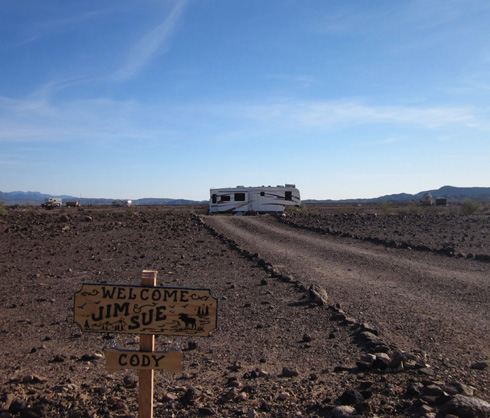
Handsome new sign at the beginning of
our driveway at Imperial Dam; this was our "front yard."
We found lots of things to visit and do in and near the LTVA:
- many miles of dirt and paved roads to ride our bikes;
- many miles of trails through the desert, low mountains, and
canyons to hike;
- wildlife to watch (birds at the lakes, free-roaming burros and
other critters, etc.);
- interesting scenery and sunrises/sunsets to photograph;
- nearby Yuma Proving Grounds, where much of our military artillery
is tested and troops are trained in desert warfare;
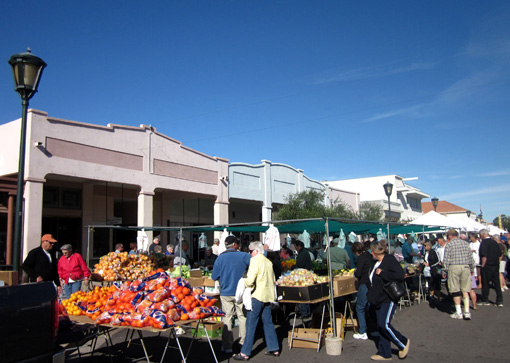
The weekly Yuma North End
farmers' markets were always well attended.
- thousands of acres of verdant cropland in Imperial Valley;
- Imperial Wildlife Conservation Area, where we hiked;
- farmers' markets, festivals, parks, museums, and shopping in Yuma;
- Quartermaster Depot and visitor center in Yuma;
- Imperial Sand Dunes
- Los Algodones, Mexico nearby for U.S. citizens without health insurance
who want less expensive prescription drugs, dental work, and/or
eye glasses.
Jim made two major modifications to the Cameo while we were at
Imperial Dam: adding four new 100-watt solar panels to the roof
and upgrading the shackles and bolts that attach the springs to
the frame. He plans to write
two illustrated entries about these installations.
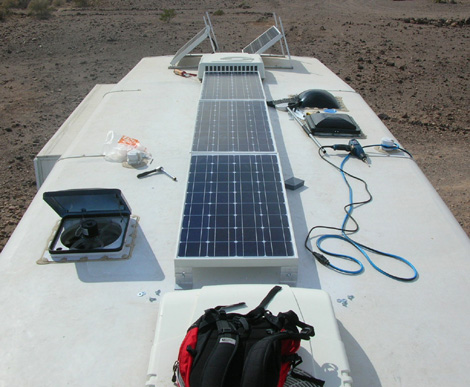
Work in progress as Jim adds new solar
panels to our camper. All five tilt. (3-5-12)
You can read more about LTVAs and other free or inexpensive
snowbirding opportunities in the desert Southwest on Bob
Diffley's
website.
WHERE ARE ALL THE SPRING-TIME DESERT
WILDFLOWERS?
We enjoyed our stay at Imperial Dam LTVA but we were ready to
leave by mid-March. Ten weeks is the second-longest we've ever stayed
any one place in our RV.
One of the things I looked forward to this spring was seeing
masses of desert wildflowers like those I'd seen in photos from
Anza-Borrego State Park, Joshua Tree National Park, and Death
Valley National Park in southern California. We've never been in
the Southwest deserts in March or April; we usually spend
late winter/early spring in southern Texas.
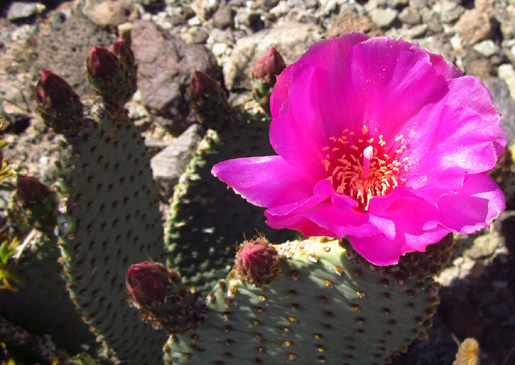
Prickly pear cacti (above) and some
wildflowers were blooming at Imperial Dam by mid-February.
We researched all three of those desert parks, including talking
with other RVers who've spent time there, but decided not to go
farther west to visit any of them this time. The main reason was
the lack of wildflowers this year. The area receives only 2-4"
of rain annually in a good year; it got even less
this year and predictions were for a poor season for
wildflowers.
So we began our long trek eastward, stopping at four places in
Arizona before returning to Virginia. We did see some pretty
cactus blooms and other spring wildflowers in these places but
no classic sweeping vistas of them.
Maybe next year . . .
ORGAN PIPE NATIONAL MONUMENT: MARCH
14-16
We spent just two nights in our first visit to Organ Pipe but we
stayed busy there and saw quite a bit of the park while we
hiked, biked, and went on a van tour of the Ajo Mountains.
Numerous cacti, shrubs, and wildflowers were blooming in the
park, including bright yellow brittlebush (foreground) and
creosote bushes:
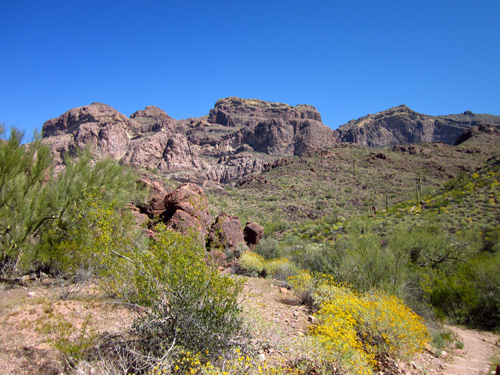
The campground at Organ Pipe is very nice and the hosts and
rangers were very friendly. I was surprised it was only about
15% occupied.
About 200 pull-thru sites are nestled among the signature organ
pipes and other types of cacti, shrubs, and trees. There are no
hookups.
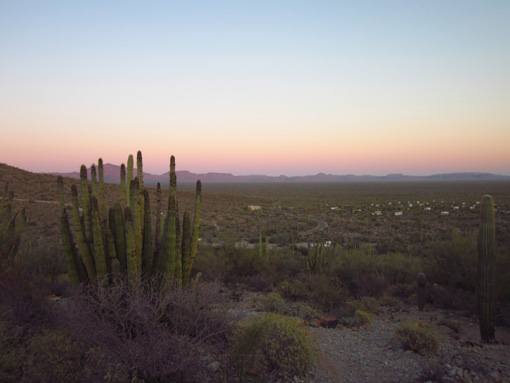
Partial view of the campground at sunset
from the Desert View Trail (3-14-12)
The downsides were very limited generator hours and no
TV reception. We did have good phone and internet (MiFi)
connections, despite being in a very remote area of southern AZ
only a few miles from the Mexican border.
Since we have National Park Service senior passes our park entry
was free and campsites were half price ($6/night).
I guess the last laugh was on us. Two days after we left we read
in a Tucson newspaper that most of Organ Pipe is closed to
visitors because of the danger of Mexican illegals and
drug-runners! No one at the visitor center or campground told us
about that and we saw no signs prohibiting entry to any areas,
including the rather remote trail to Victoria Mine:
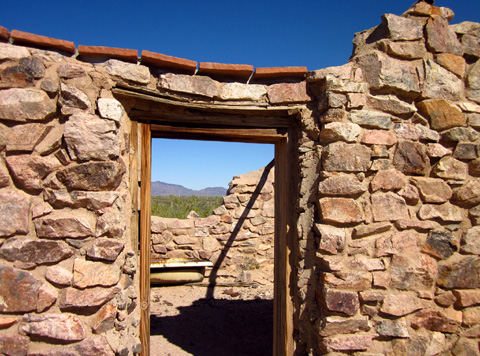
Remains of a stone structure at the
abandoned Victoria Mine at Organ Pipe,
within sight of the Mexican-US border; I
was alone on this hike! (3-15-12)
Wow. I really liked Organ Pipe.
I'm glad we didn't know it was dangerous until after we'd been
there or we wouldn't have gone. If those problems continue I
doubt we'll ever go there again, and that's a shame.
TUCSON, TAKE 2: MARCH 16-22
We returned to Davis-Monthan AFB for six more days and
deliberately stayed in a full hook-up site instead of the
overflow dry camping area because three cold, wet days were
predicted during our stay. We knew we wouldn't get much benefit
from our solar panels. Full hook-ups also gave us a chance
to more thoroughly clean Cody and the camper after almost three
months of boon-docking.
I liked this site better then the one we had in December
because we were at the end of a row and had a bigger "side yard:"
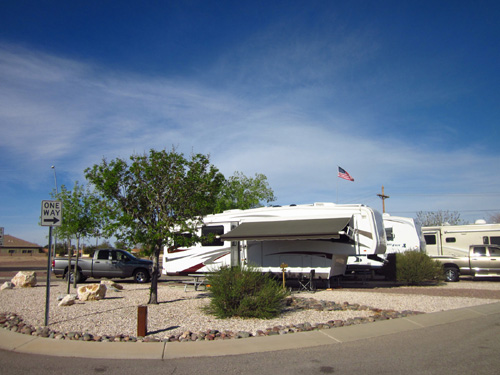
It was interesting to talk with some of the people that we'd met in
December who were still there and to see how different the
trees, shrubs, and flowers looked. Spring had definitely sprung!
I haven't been able to identify either of these unusual flowers
on shrubs
I photographed at Davis-Monthan:
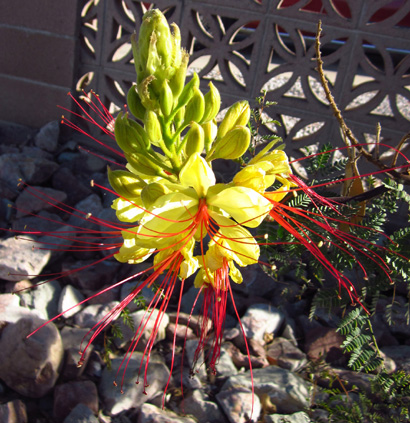
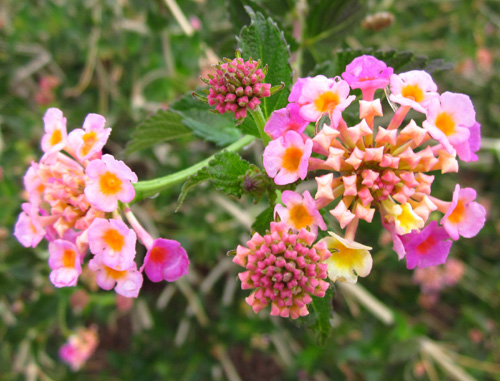
Because of the weather we spent more time in the campground this time. On one of the
three sunny days I did another all-day hike in Sabino Canyon. We
also did shorter rides and walks on base.
We will definitely return to this campground. It would be a good
place for us to boon-dock for one or two months in the winter.
BLM LAND EAST OF SAFFORD, AZ: MARCH
22-26
We enjoyed the next three nights camping for free in a dispersed
BLM site near Safford, AZ.
We had plenty of room, as the only
other RVers were a small group of boon-dockers from the Escapees
Club that had been hop scotching around the Southwest all
winter.
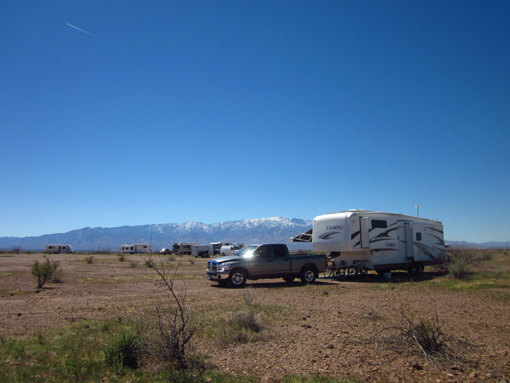
Plenty of room -- and free, except for some
propane and gasoline (3-22-12)
I loved the views of nearby 10,730-foot Mt. Graham and the
Pinaleña Mountains.
One day we drove up into the mountains and had great views of
the expansive valleys to the east and west. Cody got to play in
some snow before we came back down. We went from 3,000 feet to
9,200 feet through six different eco-zones during that drive.
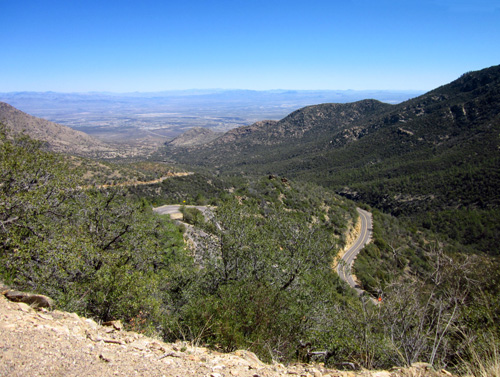
Expansive view to the east, as seen from part way up Mt.
Graham (3-23-12)
Another day I drove to the nearby Gila Box Riparian National
Conservation Area with Cody and hiked while Jim did a long bike
ride near the campground.
That afternoon we drove up to the Morenci Mine, the largest
open-pit copper mine in the U.S. and one of the largest in the
world. This is just one part of it -- a very colorful
part:
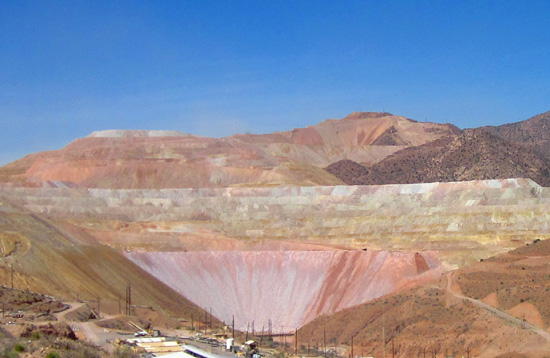
We were hoping to do a mine tour but they are not offered any
more. Rats.
The morning we left the Safford area we stopped at two other places, both free,
that we highly recommend.
The first is the Discovery Park Campus in
the southwest part of town where, among other things, we browsed
the interactive exhibits, talked with the director about the
center's camera obscura and the 20" telescope in the
observatory, and took
a simulated ride through the solar system. We were the only
visitors during the hour we toured the facility, which was nice.
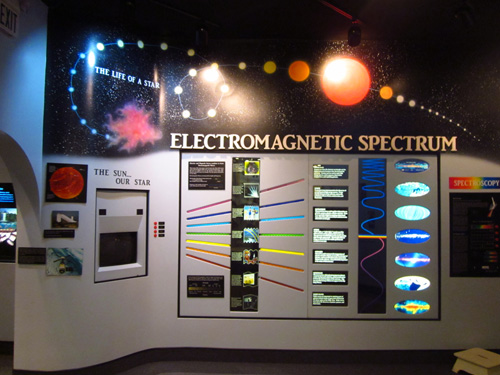
One of the interactive exhibits at the
Discovery Center (3-26-12)
We also enjoyed an educational personalized tour of the Mills Indian Pottery Collection at the
impressive student services center on the campus of Eastern AZ
College in Thatcher, just west of Safford:
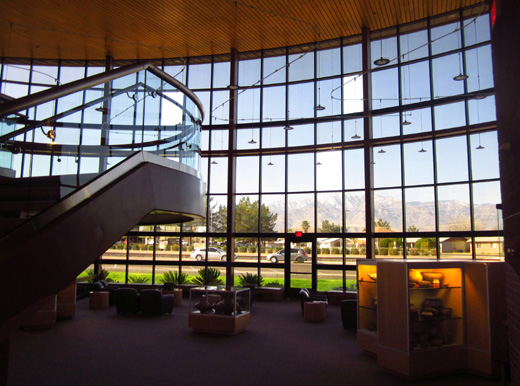
Numerous examples of Indian pottery and other artifacts from
1000-1450 AD are showcased on two levels of this bright atrium,
which has scenic views of Mt. Graham in the distance.
There is also an interesting clock tower outside the student
services building with sculptures and quotes paying tribute to
the people who made it possible for students to get an education
here:
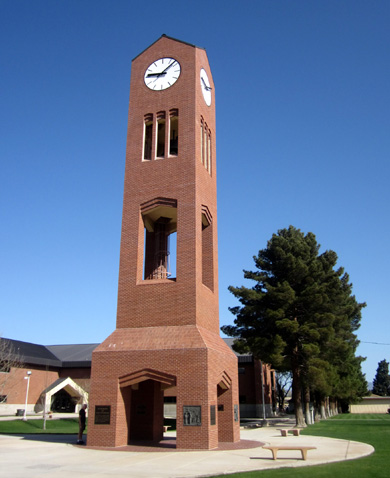
We really enjoyed visiting both places.
LAKE ROOSEVELT, AZ: MARCH 26-28
Lake Roosevelt is a long lake about three hours (in an RV)
north of Safford. There are over 1,500 National Forest Service
campsites in dozens of campgrounds on the west side of the lake.
We didn't know where Dale and Gwen, our Cameo friends, had
camped when they were there. We picked the Cholla Campground
sight-unseen from the Tonto NFS website description and it was a
very good choice. We spent just two nights in a nice back-in
site with views of the lake to the east and the Four Peaks that
are depicted on AZ license tags to the west:
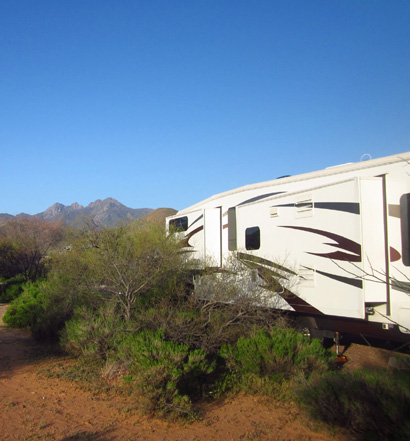
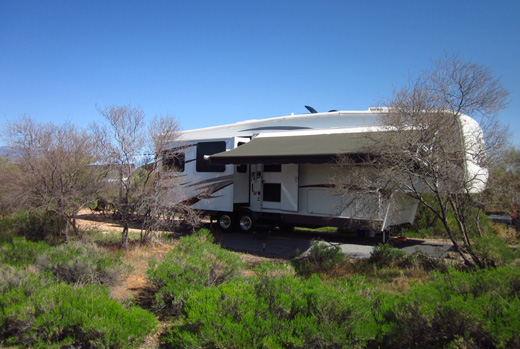
Sites at Cholla do not have hook-ups but the generator hours are
very liberal. Water and spacious restrooms are available in the campground.
The nearby
dump station was closed the days we were there; that wasn't a
problem for us since we were there only two nights. We paid a
paltry $3/night with our senior passes.
We were again surprised to have good phone and internet signals
(no TV signals without satellite service).
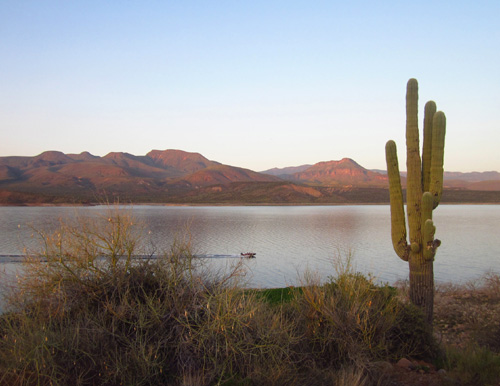
The setting sun colors the mountains east
of the lake as a fisherman
motors toward one of the docks.
(3-26-12)
Besides riding our bikes and taking walks in the scenic
campground, we went to the visitor center twice, visited the
Roosevelt Dam twice, and went to the Tonto National Monument to
hike up to a cliff dwelling. All are convenient to the Cholla
CG.
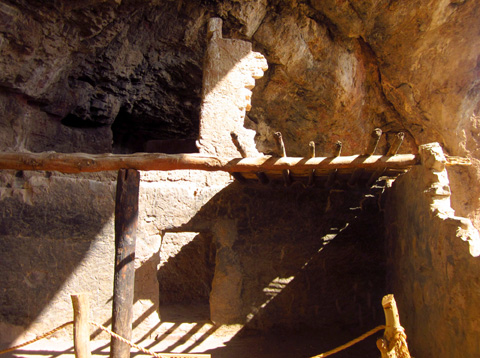
Inside one of the cliff dwellings at Tonto
Natl. Monument (3-27-12)
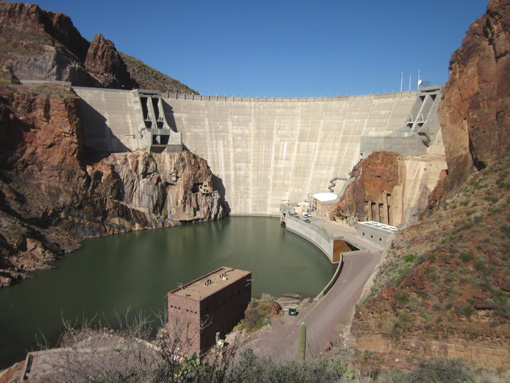
Down-river at Roosevelt Dam (3-26-12)
Lake Roosevelt is very popular with folks who fish. Since
winters are usually mild in this area Cholla CG is open
year-round. It is an hour's drive to any towns for groceries,
supplies, and a laundry, however.
Some retirees managed to stay here all winter for only $3/day in
camping fees. Since we don't fish we'd have trouble finding
enough to do in this area for several weeks or months. We'd like
to come back again for a few days, though. It's a beautiful area
and the price is right.
BACK TO OUR HOUSE
If the eastern part of the U.S. hadn't had such a mild winter
and early spring, we would have stayed in AZ a couple weeks
longer. Although it was getting right toasty in the southern
half of the state by the end of March we could have explored the
cooler area around Flagstaff and the Grand Canyon before heading
back to our house.
Alas, spring arrived in the Roanoke Valley about three weeks
earlier than average. Our neighbor was already having to mow our
lawn and the weeds were popping up in the flower beds faster
than the flowers. That's one downside to owning a house when
we'd rather be traveling in our RV.
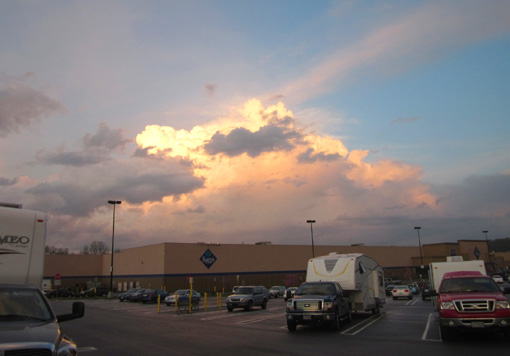
Last night on the road, sharing the Sam's
Club parking lot with two over RVs (3-31-12)
We didn't seriously consider leaving the Cameo out West this
spring, not because of the problems we had in December with
winter weather but because Jim needed to do more work on it.
It was more practical to do some brake work and other
maintenance in our back yard than at any campground (most places
frown on that). Ditto for a thorough cleaning inside and out,
unpacking, and re-packing for our summer trip to Alaska. It was
also very nice to have our own kitchen, bedroom, and bathroom on
the drive back home.
Next entry: our annual spring visit to our house in
Virginia; should we talk to some real estate agents
again??
Happy trails,
Sue
"Runtrails & Company" - Sue Norwood, Jim O'Neil,
and Cody the ultra Lab
Previous
Next
© 2012 Sue Norwood and Jim O'Neil